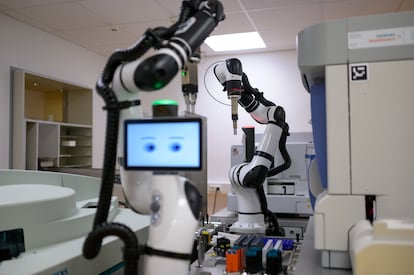We are entering the era of the robot scientist
The robots proposed by Hiroaki Kitano, Sony’s chief technology officer, could test all the imaginable hypotheses generated by an artificial intelligence system and discard the incorrect ones

Science has transformed the reality we live in; however, when one thinks about it, science is almost impossible to define. Generally, scientists study aspects of reality, which can be measured (although this is not always the case) and try to create more or less logical relationships between those aspects. This then allows us to predict events that we find interesting or useful, for example, the precise date of an eclipse, tomorrow’s weather forecast, or the effectiveness of a drug. There are many archetypes of scientists: physicists-theoreticians, biochemists, geologists, neuroscientists… Each one studies or illuminates certain aspects of reality using different techniques and paradigms. For me, the only possible definition is that “science is what scientists do.”
Physicists, for example, use intuition, while mathematics, use computation and experiments, etc. It’s a process where discoveries arise from a mixture of prior knowledge, collaboration, competition, chance, brute force and — in some cases — stubbornness, in not giving up on an idea that everyone around you thinks is pointless. Of course, science does not faithfully follow the so-called scientific method, which idealizes our messy activity as an algorithmic process, where models are formulated based on hypotheses that are later validated, or falsified, by comparing them with real data.
Discovery happens chaotically: hypotheses are abandoned, they are modified on the fly, ideas are found in unexpected places, especially as a reward for hard work and perseverance. In fact, these narratives about the scientific method as an orderly process pave the way for the exploitation of those who carry out the hardest part of science: the PhD students, fellows and postdocs, with precarious working conditions, who spend endless hours. The complexity and the difficulty of the work is covered up with narratives about the rationality of the scientific method.
Deciding whether something is respectable science is an even more complex process: a dialogue between scientists, society, politics and history decides whether something deserves to be recognized as science or not. Science is conservative, and proposing new ideas that go outside the narrow framework of what is accepted is normally a very tough battle: the scientific journal Nature recently published a study that confirms that, today, it is harder than ever to be a disruptive scientist. If you want to do well as a scientist, you need to be a man, middle class, and, above all, follow what most scientists in your field are doing.
What can be said about science is that we place reason and logic at the center. Practicing science is an established way of asking to what extent logic describes reality. Two very important examples of this are Kurt Gödel’s famous incompleteness theorems on the limitations of logic in arithmetic (proved in 1931) and the famous Turing machine (1936), which helps scientists understand the limits of algorithmic calculation, and led to the arrival of digital computers.
It was precisely the arrival of digital computers, in the middle of the 20th century, that allowed us to study and apply logic more objectively; understand its ability to decipher aspects of reality; and even try to modify it in an automated way, using machines. It’s therefore not surprising that scientific discoveries have been an important topic in artificial intelligence research since the 1960s. With the significant advances in AI in the last decade, this idea is beginning to gain traction.
A few weeks ago, Hiroaki Kitano, a robotics pioneer, who is currently the chief technology officer at Sony, visited us at the Oxford Physics Department to give us a seminar on his plan to create a robot capable of winning a Nobel Prize. It’s an initiative he calls the Nobel Turing Challenge. Kitano’s main thesis is that, if one manages to automate the manual and repetitive work of the laboratory, a scientific robot could test all imaginable hypotheses and discard the incorrect ones. Kitano proposes that these robots would eliminate the need for intuition and serendipity in research. Kitano’s robots would carry out the scientific method based on brute force, capable of testing all the possibilities that an AI system can generate.
It is an interesting philosophical proposition: it implies that such hypotheses can be explored in finite time, but perhaps underestimates the fact that most scientific communities are extremely resistant to progress. Likely because of this, the proposal is going to be tested, and not only in Japan. On November 1, the Defense Advanced Research Projects Agency (DARPA), of the U.S. Department of Defense, announced a new program called Foundation Models for Scientific Discovery, which aims to explore, develop and demonstrate how an AI agent could be a freelance scientist. We are entering the era of the robot scientist.
While listening to Kitano’s lecture, In Praise of Shadow — a 1933 essay by Jun’ichirō Tanizaki — kept coming to mind. In the brilliant work, Tanizaki reflects on aesthetics in an era in which Japan had become a modern, industrialized country, illuminated by electric light. Tanizaki explores how the West “spares no pains to eradicate even the minutest shadow” with the light of progress, and observes how the Japanese also began to forget about “the magic of shadows.”
Tanizaki prompts us to question if it makes sense to try to illuminate everything and give up on the “world of shadows.” I believe that when it comes to AI, we are in a similar position to Tanizaki. With or without electric light, with or without robots, our deep relationship with reality is not only based on illuminating objects with reason, but also on entering into the mysterious darkness, which in its immensity offers us infinite possibilities to continue finding the rational treasures that are hidden in the shadows. It seems that soon we will be able to search for these treasures with robot scientists.
Sign up for our weekly newsletter to get more English-language news coverage from EL PAÍS USA Edition
Tu suscripción se está usando en otro dispositivo
¿Quieres añadir otro usuario a tu suscripción?
Si continúas leyendo en este dispositivo, no se podrá leer en el otro.
FlechaTu suscripción se está usando en otro dispositivo y solo puedes acceder a EL PAÍS desde un dispositivo a la vez.
Si quieres compartir tu cuenta, cambia tu suscripción a la modalidad Premium, así podrás añadir otro usuario. Cada uno accederá con su propia cuenta de email, lo que os permitirá personalizar vuestra experiencia en EL PAÍS.
¿Tienes una suscripción de empresa? Accede aquí para contratar más cuentas.
En el caso de no saber quién está usando tu cuenta, te recomendamos cambiar tu contraseña aquí.
Si decides continuar compartiendo tu cuenta, este mensaje se mostrará en tu dispositivo y en el de la otra persona que está usando tu cuenta de forma indefinida, afectando a tu experiencia de lectura. Puedes consultar aquí los términos y condiciones de la suscripción digital.
More information
Archived In
Últimas noticias
EU’s prestige at stake with proposal to fund Ukrainian war effort with Russian assets
Mustafa Suleyman: ‘Controlling AI is the challenge of our time’
Venezuela breaks energy agreements with Trinidad and Tobago due to alleged complicity with the US
The murder of Michele and Rob Reiner: A tale of horrific days in Hollywood
Most viewed
- ‘El Limones’ and the growing union disguise of Mexican organized crime
- Christian Louboutin: ‘Young people don’t want to be like their parents. And if their parents wear sneakers, they’re going to look for something else’
- ‘We are dying’: Cuba sinks into a health crisis amid medicine shortages and misdiagnosis
- A mountaineer, accused of manslaughter for the death of his partner during a climb: He silenced his phone and refused a helicopter rescue
- The low-cost creative revolution: How technology is making art accessible to everyone










































